Jacksons Antique Sculptures and Carvings
to
4
4
3
1
1
3
3
2
1
1
4
4
4
4
4
4
Japanese Bronze Okimono Sculpture by Yamamoto Kozan
Located in Newark, England
YOUNG MAN WOOD CUTTING
From our Japanese collection, we are pleased to offer this Japanese Bronze Okimono by Yamamoto Kozan. The Japanese Bronze Sculpture cast in Bronze with a natu...
Category
Early 20th Century Japanese Meiji Sculptures and Carvings
Materials
Bronze
Japanese Edo Period (1603-1868) Skeleton Foetus Netsuke
Located in Newark, England
Laying Foetus
From our Japanese collection, we are pleased to offer this Japanese Edo Period Skeleton Netsuke. The Skeleton Netsuke is carved from Boxwood depicting a skeleton in t...
Category
Antique Mid-19th Century Japanese Edo Sculptures and Carvings
Materials
Wood, Boxwood
Japanese Meiji Period Bronze Monkey Group Sculpture Okimono Shosai
Located in Newark, England
Featuring Seven Japanese Macaques
Form our Japanese collection, we are delighted to offer this Japanese Bronze Monkey Group by Shosai. The Japanese Bronze Group displaying a male father monkey and his infants playing around and being mischievous with Persimmon fruit. The monkeys modelled as Japanese macaque monkeys (snow monkey). The bronze okimono is beautifully patinated with a highly lifelike and naturalistic casting signed to the underside Shosai 正齊鋳. The Bronze group dates to the Meiji Period (1868-1912) circa 1885.
Japanese macaque (snow monkey) is a terrestrial Old World monkey species that is native to Japan. They are known as snow monkeys because some live in areas where snow covers the ground for long periods each year hence their nickname. No other non-human primate lives further north or in a colder climate than the snow monkey. Individuals have brownish grey fur, pinkish-red faces, and short tails. Two subspecies are known and their conservation Status is of least concern. In Japan, the species is known as Nihonzaru ニホンザル, 日本 (Japan/Nihon) and saru 猿 (monkey) to distinguish it from other primates, but the Japanese macaque is the only species of monkey in Japan.
The Japanese macaque features heavily in the religion, folklore, and art of Japan, as well as in proverbs and idiomatic expressions in the Japanese language. They are often seen in paintings, block prints and represented in all manner of carvings from Okimono to netsuke. Many of these art forms reside in the world’s most famous museums and collections, some of the most prominent pieces by artists such as Mori Sosen and Kawanabe Kyosai. In Shinto belief (Japan’s indigenous religion/nature religion) legendary mythical beasts known as raiju sometimes appeared as monkeys and kept Raijin (the god of lightning/storms) company. In another well known tale the three wise monkeys who warn people to “see no evil, hear no evil and speak no evil” can be seen depicted in relief over the door of the famous Tosho-gu shrine in Nikko.
Meiji Period was an era of Japanese history that spanned from 1868 to 1912. It was the first half of the Empire of Japan, when the Japanese people began to build a paradigm of a modern, industrialised nation state and emergent great power, influenced by Western countries and aesthetics. As a result of radically different ideas, the changes to Japan were profound and it affected the social structure, politics, economy, military, and foreign relations across the board. The period corresponded to the reign of Emperor Meiji and was preceded by the Keio era and was succeeded by the Taisho era.
Cultural Art during the Meiji Period was of particular interest to the government and they overhauled the art export market which in turn promoted Japanese arts via various world’s fairs, beginning in Vienna at the world fair in 1873. The government heavily funded the fairs and took an active role organising how Japan’s culture was presented to the world including creating a semi-public company named Kiritsu Kosho Kaisha (First Industrial Manufacturing Company). The Kiritsu Kosho Kaisha was used to promote and commercialise exports of Japanese art and established the Hakurankai Jimukyoku (Exhibition Bureau) to maintain quality standards. For the 1876 Centennial International Exhibition in Philadelphia, the Japanese government created a Centennial Office and sent a special envoy to secure space for the 30,000 items that would be displayed. The Imperial Household also took an active interest in arts and crafts, commissioning works by select artists to be given as gifts for foreign dignitaries further emphasising the high quality and importance of Japanese art. Just before the end of the 19th century in 1890, the Teishitsu Gigeiin (Artist to the Imperial Household) system was created to recognise distinguished artists. These artists were selected for their exceptionally high quality wares and talent in their own industry. Over a period of 54 years Seventy artists were appointed, amongst these were ceramicist Makuzu Kozan and cloisonné enamel artist...
Category
Antique Late 19th Century Japanese Meiji Sculptures and Carvings
Materials
Bronze
Japanese Bronze Pheasant Okimono Genryusai Seiya
Located in Newark, England
Unusual Casting of a Pheasant in Flight
From our Japanese collection, we are delighted to offer this Japanese bronze okimono of a Pheasant upon a naturalistic root wood base. The Ph...
Category
Antique Late 19th Century Japanese Meiji Sculptures and Carvings
Materials
Bronze
Related Items
Antique Japanese wooden Buddha statue/Edo period/seated Tathagata statue
Located in Sammu-shi, Chiba
This is a wooden Buddha statue made around the Edo period (1603-1868).
It is likely to be Amida Nyorai, the highest-ranking Buddha statue, which is an enlightened being.
This Buddha ...
Category
Antique 18th Century Japanese Edo Sculptures and Carvings
Materials
Cypress
$2,000
H 19.69 in W 16.54 in D 6.89 in
Japanese antique stone god/[Daikokuten]/Stone Buddhas from the Edo period
Located in Sammu-shi, Chiba
Do you know what Daikokuten is?
This god in Japan is an old god who has existed since the end of the Muromachi period (16th century) as one of the seven gods who bestow happiness.
He...
Category
Antique 18th Century Japanese Edo Sculptures and Carvings
Materials
Stone
$800
H 8.47 in W 5.12 in D 4.34 in
Pair of Japanese Edo Period Musha Ningyo Courtier Dolls
Located in Austin, TX
Two exquisite Japanese musha ningyo dolls, crafted as courtiers, Edo Period, early 19th century, Japan.
The older man can be identified as the h...
Category
Antique Early 19th Century Japanese Edo Sculptures and Carvings
Materials
Shell, Brocade, Silk, Glass, Wood, Paint, Paper
Signed Japanese Meiji Period Bronze Crab (E) Okimono
Located in Chapel Hill, NC
Signed Japanese okimono of a realistically modeled crab raised up on its toes and with claws raised. One of 5 designated by (E) in the title.
Category
Antique Late 19th Century Japanese Meiji Sculptures and Carvings
Materials
Bronze
Japanese Carved and Lacquered Wood Shogun, Edo Period, 19th Century, Japan
Located in Austin, TX
An unusual Japanese carved wood, lacquer, and gilt decorated portrait sculpture of a shogun, Edo Period, early 19th century, Japan.
The unidentified shogun (possibly Tokugawa Iey...
Category
Antique Mid-19th Century Japanese Edo Sculptures and Carvings
Materials
Wood, Lacquer
$2,800
H 10.25 in W 10.5 in D 7.5 in
Signed Japanese Meiji Period Bronze Crab (D) Okimono
Located in Chapel Hill, NC
Signed Japanese bronze okimono of a naturalistically modeled crab on its toes and with claws raised. One of five designated by (D) in the title.
Category
Antique Late 19th Century Japanese Meiji Sculptures and Carvings
Materials
Bronze
Japanese Cast Bronze Hairy Crouching Rabbit Sculpture
Located in Douglas Manor, NY
1631 Japanese Hand cast bronze rabbit
Category
Early 20th Century Sculptures and Carvings
Materials
Bronze
Genryusai Seiya Japanese Meiji Man & Water Buffalo Sculpture on Stand
Located in Bishop's Stortford, Hertfordshire
An exceptional Japanese Meiji bronze sculpture of a man and water buffalo on a natural polished oak stand by renowned Japanese master craftsman Genryusai Seiya and dating from around 1880/90. The large bronze depicts an elderly man holding a pipe and tobacco pouch...
Category
Antique 1880s Japanese Anglo-Japanese Sculptures and Carvings
Materials
Bronze
$12,629 Sale Price
44% Off
H 13.78 in W 17.33 in D 5.52 in
Japanese Antique small Stone Buddha/Jizo Bodhisattva/ Edo /1750-1868/ Wabi sabi
Located in Sammu-shi, Chiba
If you want something special, we recommend purchasing items selected by Brood.
We sell carefully selected old Japanese items.
I've seen tens of thousands of items so far.
Based on t...
Category
Antique Late 18th Century Japanese Edo Sculptures and Carvings
Materials
Sandstone
$1,427
H 13.78 in W 9.06 in D 3.94 in
Large Japanese Meiji Period Bronze Crab (C) Okimono
Located in Chapel Hill, NC
Realistically modeled Japanese okimono of a crab raised on its toes. I of 5 designated by the (C) in the title.
Category
Antique Late 19th Century Japanese Meiji Sculptures and Carvings
Materials
Bronze
Edo Period Stone Buddha/1600’s/Japanese Antique Buddha Statue/Garden Ornament
Located in Sammu-shi, Chiba
This stone Buddha sculpture, believed to date back to the early Edo period or earlier, depicts Jizo Bosatsu in a seated pose.
Crafted from granite, it showcases the natural effects ...
Category
Antique Early 17th Century Japanese Edo Sculptures and Carvings
Materials
Stone
$1,427
H 13 in W 8.67 in D 3.94 in
Japanese antique wall-hanging wooden Buddha statue/Edo period/1603-1868/Wabisabi
Located in Sammu-shi, Chiba
This is a wooden Buddha statue made around the Edo period in Japan.
Although it is a small Buddha statue, it has a strong presence and is beautiful.
Originally, there was a wooden pe...
Category
Antique 18th Century Japanese Edo Sculptures and Carvings
Materials
Cypress
$800
H 6.03 in W 6.89 in D 2.76 in
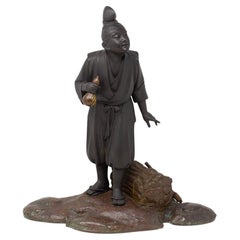
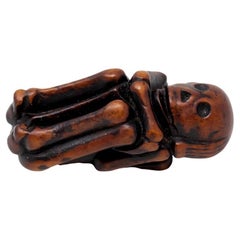
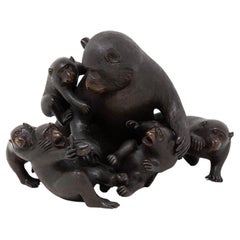
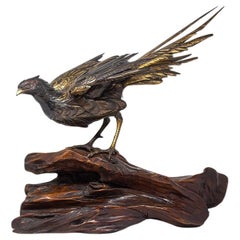
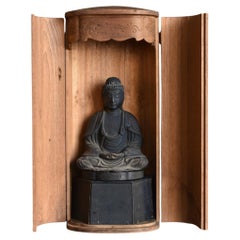
![Japanese antique stone god/[Daikokuten]/Stone Buddhas from the Edo period Japanese antique stone god/[Daikokuten]/Stone Buddhas from the Edo period](https://a.1stdibscdn.com/japanese-antique-stone-god-daikokuten-stone-buddhas-from-the-edo-period-for-sale/f_54872/f_406808721721288384637/f_40680872_1721288385010_bg_processed.jpg?width=240)